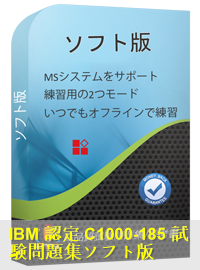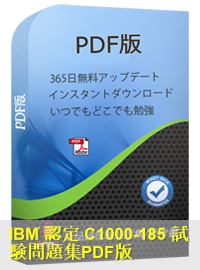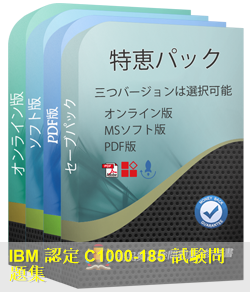GoShiken は C1000-185 試験「IBM watsonx Generative AI Engineer - Associate」のサンプル問題を無料で提供しています。購入する前、弊社の模擬試験画面や問題のクオリティー、使いやすさを事前に体験できます。
IBM watsonx Generative AI Engineer - Associate: C1000-185 試験
「IBM watsonx Generative AI Engineer - Associate」、C1000-185試験であります、IBM認定でございます。 最適な問題と解答をまとめられて、GoShiken はお客様のC1000-185試験に計 380 問をまとめてご用意いたしました。C1000-185試験の集結内容には、IBM Certified watsonx Generative AI Engineer - Associate認定にあるエリアとカテゴリの全てをカバーしており、お客様の IBM watsonx Generative AI Engineer - Associate 試験認定合格の準備を手助けをお届けします。



リアルなC1000-185テストエンジン
弊社のIBM watsonx Generative AI Engineer - Associate受験資料はお客様がIBM C1000-185試験を受けるために必要なすべてのものが含まれています。詳細はIBM watsonx Generative AI Engineer - Associate認証専門家側が研究して制作されて、彼らは業界の経験を利用して正確で論理的な制品を改良され続けています。
品質と価値のあるC1000-185試験問題
GoShiken練習試験IBM C1000-185は認定された対象分野の専門家と公開された作成者のみを招いて、最高水準の技術的精度で作成されています。
C1000-185試験合格を100%返金保証
お客様がもしGoShikenのテストエンジンを使って C1000-185 試験「IBM watsonx Generative AI Engineer - Associate」に不合格されました場合、弊社はお客様に購入金額を全額返金致します。
- C1000-185 試験に関する広範囲的な問題と解答
- C1000-185 試験問題集は事前使用できる
- 問題は業界の専門家によって調査されて、ほぼ100%正解率の検証済みの回答
- C1000-185 試験問題集は定期的に更新されます
- 本番試験を基づいてまとめられた C1000-185 問題集
- こちらの問題集は販売される前に複数回シミュレーション済み
- GoShiken で購入すると決める前に、無料で C1000-185 試験問題集のサンプルを試せます
365日無料アップデート
購入日から365日無料アップデートをご利用いただけます。365日後、C1000-185問題集更新版がほしく続けて50%の割引を与えれます。
インスタントダウンロード
お支払い後、弊社のシステムは、1分以内に購入したC1000-185問題集をあなたのメールボックスにお送りします。 2時間以内に届かない場合に、お問い合わせください。
100%返金保証
購入後60日以内に、C1000-185試験に合格しなかった場合は、全額返金します。 そして、無料で他の試験問題集を入手できます。
安全購入プロセス
弊社のC1000-185テスト連続は10年以上のビジネス経験の中で、お客様の購入権をひたすら重要視していますので、電子製品を購入する際にウイルスについて心配する必要はありません。 C1000-185試験準備の信頼性を長年にわたり評価され、保証された購入方法を提案するために限りなく努力を重ねるため、絶対的に安全な環境を構築しており、C1000-185試験問題にウイルスの攻撃されることはありません。 それについて疑いがある場合は、専門の担当者が最初にこれを処理します。また、C1000-185テストs問題セットをインストールして使用するために、リモートでオンラインで指導を受けることもできます。
すべての受験者にとって試験を簡単にするために、C1000-185試験対策ではテスト履歴の成績を確認することができます。その後、バツを見つけてそれを克服することができます。 さらに、この問題集のC1000-185試験問題をオンラインで一度利用した後は、次回オフライン環境で練習することもできます。 C1000-185テスト問題セットは、ユーザーが選択するためのさまざまな学習モードを提供いたします。これは、パソコンやスマホの複数登録ができてオンラインで勉強したり、オフラインで複数印刷するために使用できます。 値段がより安いため、より多くの選択肢が用意されています。試験のためにC1000-185試験問題を選択するのがオススメです。
提供された3つのバージョン
お客様にはさまざまなニーズを持っていることを考慮し、弊社は利用可能なC1000-185テスト問題セットを3つのバージョンで提供いたします--- PDF版、PCテストエンジン版とオンラインテストエンジン版。 最も有利なのが唯一サンプルを持つ--- Q&A形式のPDF版を無料でダウンロードできます。 こちらのバージョンはC1000-185試験準備に印刷可能で、ダウンロードすることが簡単にできます。つまり、いつでもどこでも勉強することができます。 PC版のC1000-185試験問題は実際の試験環境でリアル体験ができ、MSオペレーティングシステムをサポートします。これは試験のために勉強するためのより実用的な方法です。 さらに、C1000-185試験対策のオンラインテストエンジンは、ほとんどのユーザーがスマホ、タブレットでAPPを学習操作することに慣れているため、ほとんどの受験者の間で高い期待を寄せているようです。 それぞれのバージョンが同じ内容であることを保証します。お客様は自分が便利だと思うバージョンをお選びください。
IBM watsonx Generative AI Engineer - Associate 認定 C1000-185 試験問題:
1. As a Generative AI engineer, you're tasked with optimizing the performance and cost-efficiency of a model by adjusting the model parameters.
Given that your objective is to reduce the cost of generation while maintaining acceptable quality, which of the following parameter changes is most likely to result in cost savings?
A) Increase the max tokens parameter to allow for more complex output.
B) Decrease the max tokens parameter.
C) Increase the top-k sampling value.
D) Set the temperature parameter to a higher value.
2. Your organization is deploying a generative AI model to assist in legal document generation. During testing, you discover that the model generates biased legal advice that could disproportionately affect certain social groups. Additionally, a team member raises concerns about potential data poisoning attacks on your training set.
What steps should you take to mitigate both the risks of data bias and poisoning?
A) Use adversarial training techniques to make the model more robust against bias and poisoning.
B) Apply prompt engineering techniques to avoid triggering known biases in the model.
C) Fine-tune the model using only the training data from trusted sources, without expanding the dataset.
D) Implement a data validation pipeline to detect anomalies and potential poisoning in the training data.
3. You are designing a prompt to converse with a model for multilingual translation.
How would you frame the prompt to translate an English business email to Japanese, ensuring that the translated email is formal and appropriate for a business setting in Japan?
A) "Translate this business email into Japanese, making sure the tone is formal and culturally appropriate for a business context."
B) "Translate the following business email into Japanese, focusing on word-for-word accuracy."
C) "Translate this business email into Japanese but do not consider the tone or formalities."
D) "Translate this business email into Japanese using informal language."
4. You are creating a prompt template for a generative AI model that helps technical support staff troubleshoot customer issues based on symptoms provided. The goal is to generate a clear, step-by-step diagnostic process.
What elements would improve the effectiveness of the template? (Select two)
A) Set a high temperature value to explore more creative diagnostic approaches
B) Include an instruction to ask clarifying questions when the issue is unclear
C) Provide explicit instructions to break the response into steps
D) Incorporate complex technical jargon to ensure expert-level responses
E) Ask the model to generate multiple diagnostic paths for each issue
5. You are working on a large-scale enterprise application using IBM watsonx and need to ensure that different versions of your generative AI model prompts are properly managed for deployment.
Which of the following is the most appropriate action when planning the deployment of prompt versions?
A) Embed the prompt version directly into the API request body so that the deployed model can select the correct prompt dynamically at runtime.
B) Use a deployment space in IBM watsonx to version your prompts, assigning unique tags to each version and ensuring rollback capabilities.
C) Keep prompt versions in an external document management system and manually track which versions are deployed in the application.
D) Store all prompt versions directly in the model's code repository, updating the main branch with each new version.
質問と回答:
| 質問 # 1 正解: B | 質問 # 2 正解: D | 質問 # 3 正解: A | 質問 # 4 正解: B、C | 質問 # 5 正解: B |
 389 お客様のコメント最新のコメント 「一部の類似なコメント・古いコメントは隠されています」
389 お客様のコメント最新のコメント 「一部の類似なコメント・古いコメントは隠されています」
C1000-185にあまりなじみの無い方でも「知っている言葉」で解説しているので、専門的な内容も無理なく理解することができます。
C1000-185習得しやすいですね。今回は合格なので、次回受験するC1000-182もここGoShikenで購入させて頂きます。
C1000-185試験における重要な知識を整理している。ありがたい。
ほんとうにC1000-185の問題集を買って大正解だ。必ず合格したい場合は細かな部分まで網羅してある問題集はC1000-185これ
前回送っていただいた問題集で、おかげ様で合格いたしました。
ありがとうございました。
友達にもお勧めいたします。
網羅性が高い。C1000-185素敵。
IBMのC1000-185問題集はいたれりつくせりの対策本。使い方に従って問題集一つでやっておけば試験に失敗する事は稀。
仕上げの模擬試験としてもご活用できますね。すごくいいです。C1000-185に合格できました。
私も高得点でC1000-185試験に合格した。GoShikenさん、ネットで好評させていただきます。
試験を無事合格することができました。問題はほぼ出題されました。試験の完了もはやいです。購入して良かったと思いました。
C1000-185試験によく出題される、最重要用語や問題傾向を掲載しているから気に入ってます。
これ問題集で充分対応できそう。GoShikenありがとうございます。知識もしっかりと身につくと思います。
ほかの方も記載ありましたが、このIBMの問題集の模擬試験がとても良いです。C1000-185本番の試験は、この模擬試験を解いてから望むとベストです。
GoShikenの問題集はC1000-185問題集は学ぶ内容はしっかりしたもので、仕事でもプライベートでも役立ちます。
いちばんやさしいC1000-185で学習してからがちょうどくらいだと思います。知識は勉強してからチャレンジもあります
C1000-185のアプリバージョンはおすすめです。スマートフォンからアクセスしてもできるので、電車での移動中でも利用していました。本当に受かった。サンキューGoShiken
GoShikenのC1000-185の問題集を習得して、簡単にまとめると、参考書読む、過去問解く。GoShikenのC1000-185問題集を頼りにするだけで試験に合格することができました。




